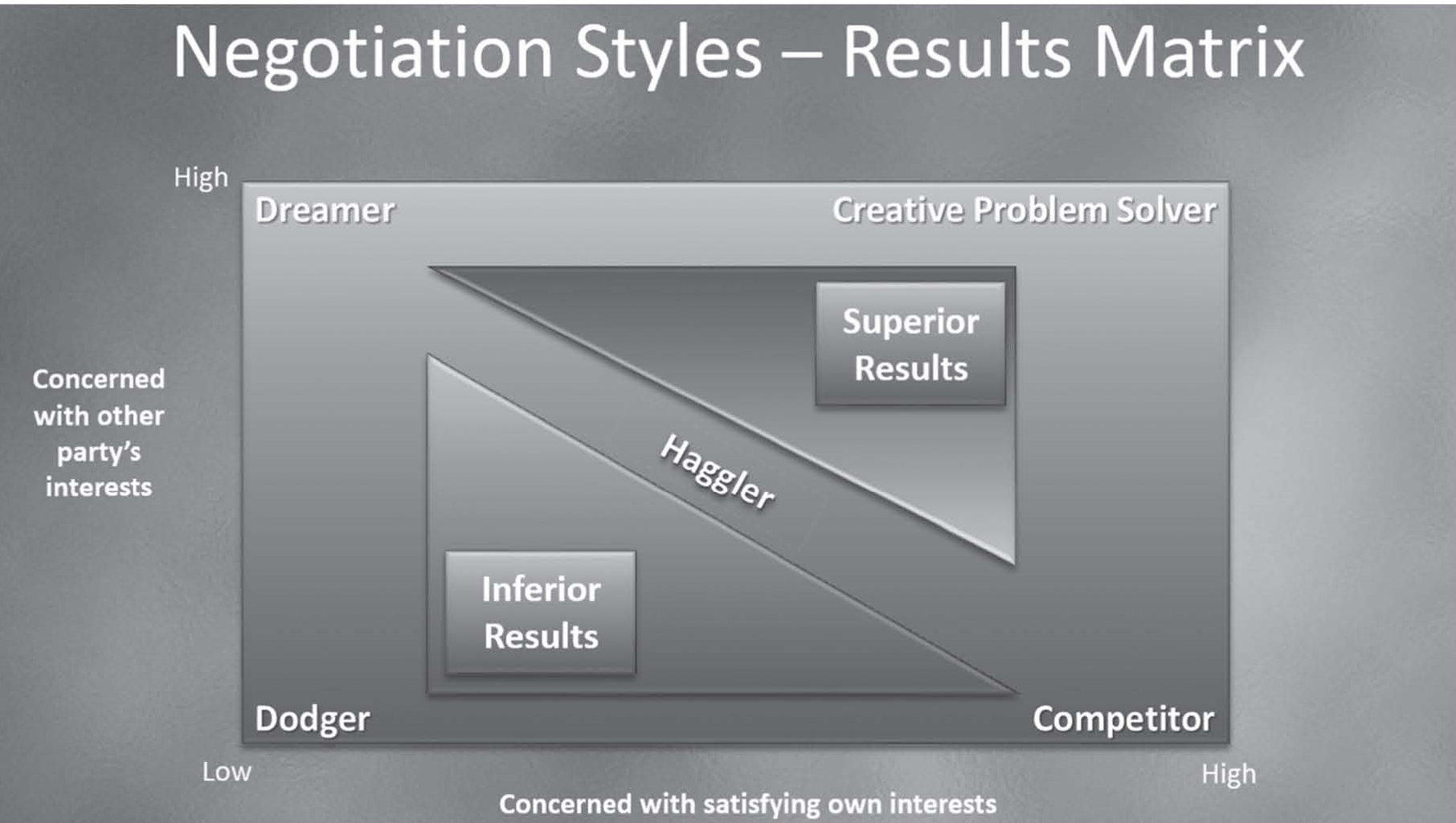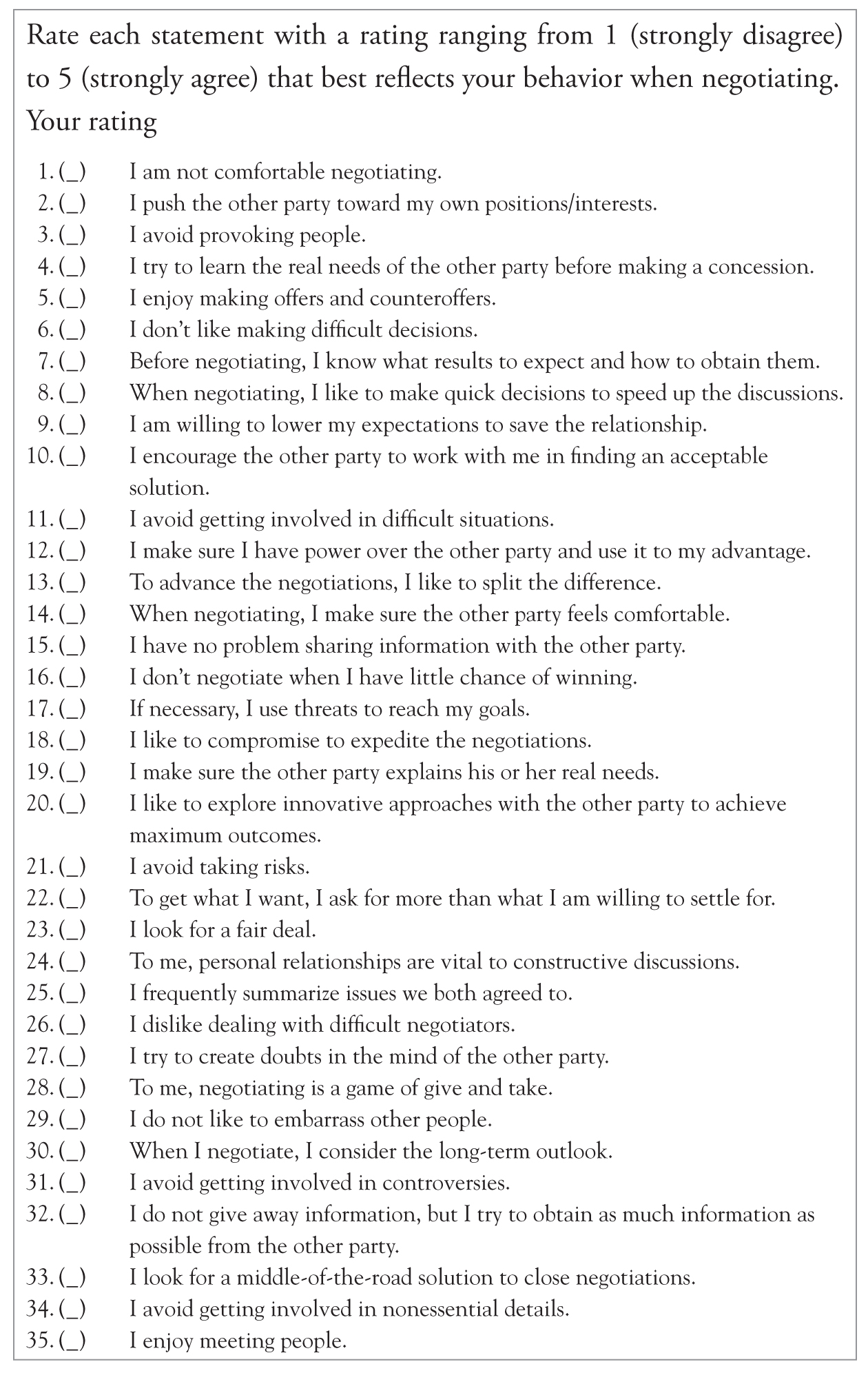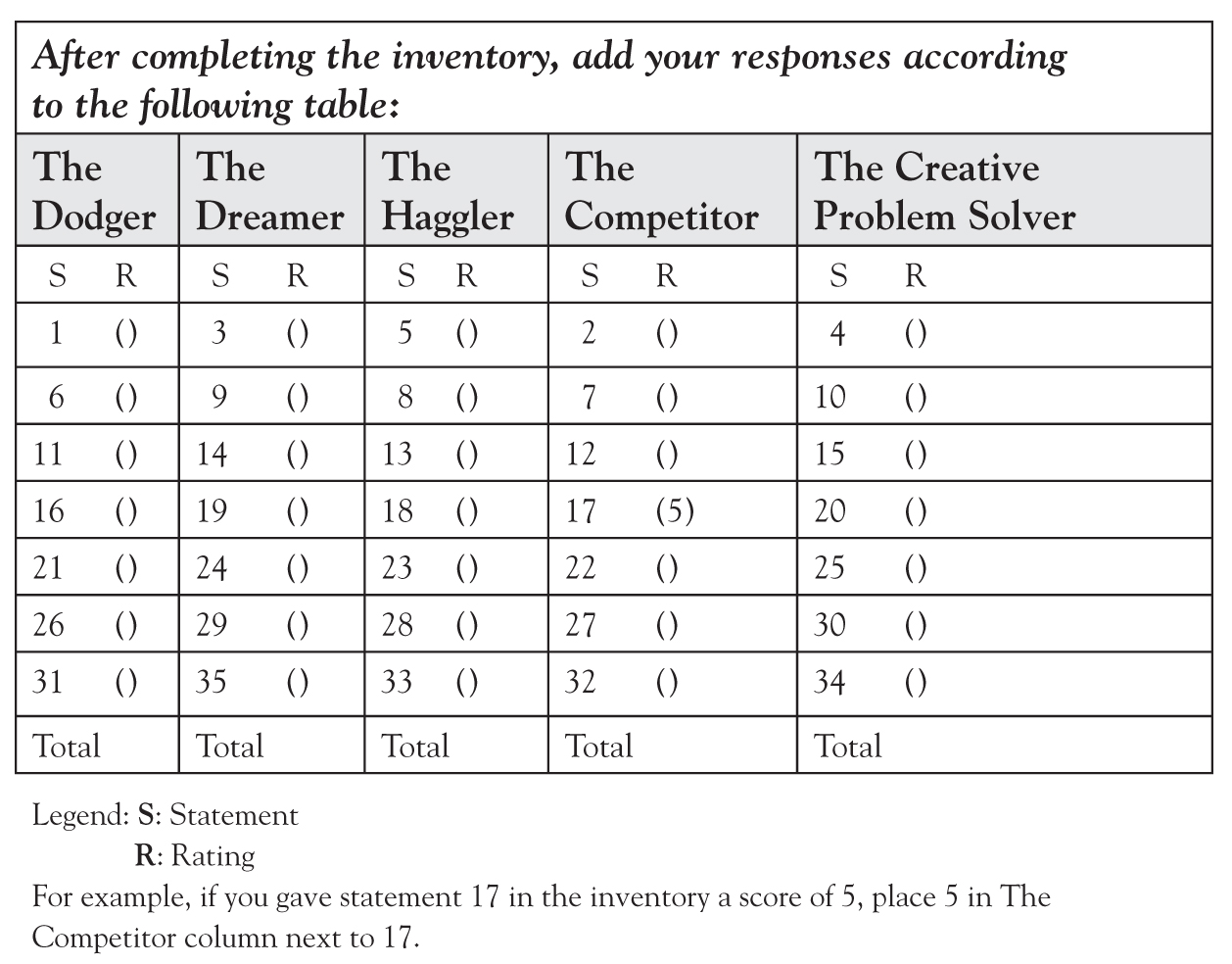Selecting Your Negotiating Style
Problem solving is the skilled negotiator’s greatest asset.
—Melanie Billings-Yun
Regardless of their past experiences, people have a preference for one approach or the other to negotiations. Over the years, they would have dealt with individuals who showed aggressive behavior, who displayed a cooperative attitude, who settled their differences through an exchange of concessions, and who withdrew from the discussion altogether. A negotiator must know his or her preferred style of negotiation as well as that of the other party. This knowledge allows the negotiator to improve his or her preparation, including selecting the most appropriate negotiation style for the situation. As every negotiation is unique, prior to entering into discussions, a negotiator should have identified the other party’s style and adjusted his or hers in order to optimize mutual benefits.
Style Differences Among Negotiators
Each negotiator applies a specific negotiating style. This depends on his or her cultural background, his or her professional responsibilities, and the context in which the discussions are taking place, as well as whether he or she is seeking a onetime deal or repeat business over the long term. Five distinct negotiation styles can be identified. These styles are influenced by two major forces—namely, relationship-oriented outcomes and substantive- or task-oriented outcomes. In most negotiations, there is a trade-off between these two orientations. Cultural characteristics play a significant role in determining the relative impact of these two orientations.1 In cultures where establishing and maintaining relationships is essential to carrying out business, the predominant negotiating style is more accommodation oriented. In competitive cultures, where only the final outcome is considered important, the negotiation style is more task oriented, relying on competitive and conflicting tactics.2
In terms of style, negotiations are grouped into five categories: dodgers, dreamers, hagglers, competitors, and creative problem solvers.
Dodgers
Generally, dodgers do not like facing situations where decisions must be made and risks assumed. In a negotiation, the dodger tries to postpone making decisions or, more likely, tries to find reasons for not getting involved at all. In other words, the dodger is a reluctant party who does not enjoy negotiating and who withdraws from the discussions or simply refuses to participate. These situations are not frequent, although they may be more common in certain cultures whereby an unwillingness to negotiate is seen as a lack of interest. In other situations, by the time the two sides meet, one party may no longer be interested in pursuing the negotiation due to a better offer received from a competitor; the party, therefore, adopts a dodging attitude. At times, executives doing business across cultural boundaries are likely to face dodgers and should decide early on whether to continue the discussions, ask for a recess, or deal only with negotiators who have decision-making responsibilities.
Dreamers
Dreamers approach negotiations with one major goal in mind; that is, to preserve the relationship even if it means giving up unnecessary concessions while reducing their own expectations. At times, they pretend to agree with the other party to maintain the relationship and goodwill, when in reality they have divergent views. In more traditional cultures, relationship plays a dominant role in negotiations. Without a relationship or without a trusted third party making an introduction, negotiations are unlikely to take place. In a competitive culture, dreamers are at a disadvantage, as their behavior is often interpreted as a sign of weakness. For example, face saving in Asian cultures is part and parcel of negotiations. Failing to take into consideration the role of relationship and face saving (or giving face) can result in negotiations that turn into deadlocks or that simply lead to breakdowns.
Dreamers are willing to accept lower outcomes on substantive issues for the sake of the relationship. Such negotiations often make sense to executives seeking entry into new markets by adopting an accommodating attitude in the hope of getting the business going. However, it is difficult to obtain a favorable agreement if concessions are given without obtaining similar ones in return.
Hagglers
Hagglers view negotiations as a give-and-take game. They are willing to lower their expectations provided they can obtain some benefits from the other party. Persuasion, partial exchange of information, and manipulation dominate the discussion. A short-term outlook and quick movements characterized with back-and-forth concessions prevail. Hagglers are flexible in their approach and seek instant compromises. As a result, hagglers fail to reach optimum outcomes, neglect details, and sometimes overlook long-term opportunities.
In their search for quick solutions, hagglers fail to identify the underlying needs of the other party. Hagglers build superficial relationships and are satisfied with splitting the difference to reach a final agreement.
This style is more suitable for one-time deals in domestic market situations. In international negotiations, where long-term relationships and trust are essential ingredients to successful implementation, haggling is not considered an effective approach that satisfies the interests of both parties.
Competitors
Competitors enjoy conflicts, feel comfortable with aggressive behavior, and employ hardball tactics. They enjoy struggling to meet their objectives, even at the cost of alienating the other side. Satisfying their own interests is their primary goal. Competitors use whatever power they have to win and fully exploit the other party’s weaknesses. They are extremely persuasive in their discussions and persist in controlling the discussions. In this type of interaction, limited information is exchanged. Generally, such situations lead to win-lose agreements, where the competitor wins most of the benefits by obtaining the majority of concessions while giving few, if any, concessions in return. Frequently, these negotiations result in a breakdown when the weaker party decides to walk away. After all, no deal is better than accepting a bad deal.
Negotiators relying on competitive strategies and tactics are found everywhere, with a greater concentration in task-oriented cultures. In these cultures, only tangible results are considered worth negotiating for. Short-term benefits override long-term gains, and relationships are often considered marginal.3 As a consequence, these negotiated agreements are unsustainable, often calling for renegotiations when the weaker party can no longer honor its commitments.
Creative Problem Solvers
Problem solvers display creativity in finding mutually satisfying agreements. They take time to identify the underlying needs of the other party in order to explore how they can best meet their mutual interests jointly. In their search for a joint solution, they take into consideration the relationship as well as the substantive issues, since both are equally important to them. Problem solvers ask plenty of questions, share information openly, and suggest options and alternatives. During the discussions, they emphasize common needs and frequently summarize what has been agreed to so far.4 They tend to have long-term vision, sometimes at the cost of short-term benefits.
During the discussions, creative problem solvers exchange relevant information and ask plenty of questions in a cooperative and constructive environment. This style of negotiation requires more time to prepare and calls for face-to-face discussions. By exploring alternatives and developing multiple options, problem solvers are able to create optimum outcomes where both parties are winners, referred to as the win-win approach.5 This negotiating style is more conducive to international business deals, where implementation over the long run determines whether an agreement is profitable.
Figure 3.1 summarizes the strengths and weaknesses of each style.

Figure 3.1 Strengths and weaknesses of different negotiation styles
Appropriate Negotiating Style
Of the five styles, creative problem solving is regarded as superior because it attempts to satisfy the needs of both parties. Creative problem solvers realize that a mutually agreeable outcome is the best insurance against the threat of competition or possible backlash from a dissatisfied party. This approach requires a negotiator to prepare thoroughly to identify his or her specific needs as well as the interests of the other party, to develop options, and to plan what concessions to make and what concessions to ask for. It also requires having an open and flexible mind, asking plenty of questions, and listening actively to fully understand the other party. In these discussions, useful information is exchanged, enabling each side to explore the full range of opportunities available to them. In the end, problem solvers place themselves in a position to improve on their expected results by enlarging the zone of agreement.6 In other words, negotiators applying the problem-solving approach are most likely to achieve superior results (also known as the Pareto frontier, where there are no possible superior outcomes) in which each party gains without giving up more or taking more from the other side.
Figure 3.2 shows how each style fits into the overall field of negotiation and how the creative problem-solving approach allows the negotiators to enter into optimum outcomes and maximizing joint gains.

Figure 3.2 Maximizing joint gains
Determining the Negotiation style
Most people rely on one or more styles depending on the situation they are in, although they probably have a predisposition for one specific negotiation style. A negotiator often adjusts the style as he or she interacts with the other party. If you are meeting a party who relies on competitive or aggressive tactics, you need to respond with appropriate tactics of your own to protect your interests.7 Equally, you need to project an image of self-confidence to the other party in order to send a message that such tactics are not conducive to satisfying both of your respective needs. In other words, despite having a tendency to use a certain style, you must modify it in light of the other party’s behavior.
You can determine your preferred negotiating style by following the procedure discussed here. First, rate each of the 35 statements in Figure 3.3, Personal Assessment Inventory, on a five-point scale with 1 (strongly disagree), 2 (disagree), 3 (have no specific view), 4 (agree), or 5 (strongly agree).

Figure 3.3 Personal assessment inventory
Whenever possible, try to avoid using a rating of 3, as this rating will not reflect your true preferences. Further, bear in mind that there are no right or wrong answers. Just make sure your rating describes your preferred style when handling a negotiating situation.
Next, enter your ratings to all the 35 statements in Figure 3.4. Each column indicates where you should enter the ratings for the statements. For example, enter your responses to statements 1, 6, 11, 16, 21, 26, and 31 in the dodger column.

Figure 3.4 Interpreting your scores
The highest total score identifies your dominant style. In most negotiations, you are likely to use a mix of styles ranging from cooperation to competition. Your prevailing style is influenced by the importance you give to the relationship, the style of the other party, the degree of competition in the target market, and your wish to seek a one-time opportunity or repeat orders over the long term.
Any ratings near the top (35) mean that you tend to rely too much on that style in handling negotiations. If you have low ratings for dodger and dreamer and high ratings for the others, you have a good base for negotiations. A high rating for competitor is good, but that style can backfire in some cultures. Ideally, a high rating for creative problem solver is considered the key ingredient for win-win solutions. You can repeat the exercise whenever you want to learn the style of the other party.
Summary
A negotiator should know his or her negotiation style as well as the style of his or her counterpart. The negotiator can then adjust his or her style to match the style of the other party, ensuring smooth negotiations.
The five different negotiation styles are dodgers, dreamers, hagglers, competitors, and creative problem solvers. Among these, the creative problem solver is considered the best style because it satisfies the needs of both parties. Generally, negotiators have two preferred styles: either creative problem solving and competing or creative problem solving and dreaming.
A negotiator can determine his or her negotiation style by following the procedure discussed in the chapter. The same procedure can be utilized to figure out the negotiation style of the other party. Each style is influenced by one of two forces: task orientation or relationship orientation.
